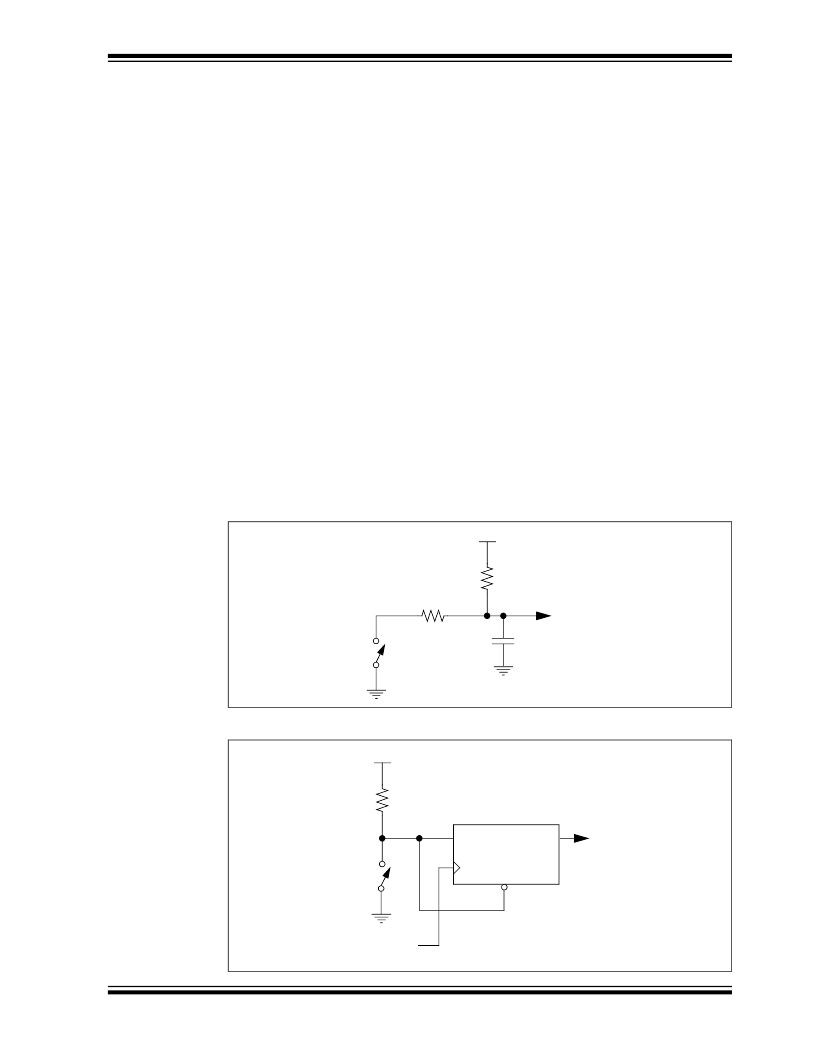- 您现在的位置:买卖IC网 > Sheet目录321 > DM164120-1 (Microchip Technology)BOARD DEMO PICKIT 2 LP COUNT
�� �
�
 �
�LPC� Demo� Board� Lessons�
�3.2.6�
�Lesson� 6:� Switch� Debouncing�
�Mechanical� switches� play� an� important� and� extensive� role� in� practically� every�
�computer,� microprocessor� and� microcontroller� application.� Mechanical� switches� are�
�inexpensive,� simple� and� reliable.� In� addition,� switches� can� be� very� noisy.� The� apparent�
�noise� is� caused� by� the� closing� and� opening� action� that� seldom� results� in� a� clean�
�electrical� transition.� The� connection� makes� and� breaks� several,� perhaps� even�
�hundreds,� of� times� before� the� final� switch� state� settles.�
�The� problem� is� known� as� switch� bounce.� Some� of� the� intermittent� activity� is� due� to� the�
�switch� contacts� actually� bouncing� off� each� other.� Imagine� slapping� two� billiard� balls�
�together.� The� hard� non-resilient� material� doesn’t� absorb� the� kinetic� energy� of� motion.�
�Instead,� the� energy� dissipates� over� time� and� friction� in� the� bouncing� action� against� the�
�forces� push� the� billiard� balls� together.� Hard� metal� switch� contacts� react� in� much� the�
�same� way.� Also,� switch� contacts� are� not� perfectly� smooth.� As� the� contacts� move�
�against� each� other,� the� imperfections� and� impurities� on� the� surfaces� cause� the�
�electrical� connection� to� be� interrupted.� The� result� is� switch� bounce.�
�The� consequences� of� uncorrected� switch� bounce� can� range� from� being� just� annoying�
�to� catastrophic.� For� example,� imagine� advancing� the� TV� channel,� but� instead� of� getting�
�the� next� channel,� the� selection� skips� one� or� two.� This� is� a� situation� a� designer� should�
�strive� to� avoid.�
�Switch� bounce� has� been� a� problem� even� before� the� earliest� computers.� The� classic�
�solution� involved� filtering,� such� as� through� a� resistor-capacitor� circuit,� or� through�
�re-settable� shift� registers� (see� Figures� 3-4� and� 3-5).� These� methods� are� still� effective�
�but� they� involve� additional� cost� in� material,� installation� and� board� real� estate.� Why�
�suffer� the� additional� expense� when� software� is� free� and� program� memory� is� abundant.�
�FIGURE� 3-4:�
�FILTERING� DEBOUNCE� SOLUTION�
�+V�
�R2�
�R1�
�Filtered�
�Switch�
�SW�
�C� 1�
�Output�
�FIGURE� 3-5:�
�SHIFT� REGISTER� DEBOUNCE� SOLUTION�
�+V�
�R1�
�D�
�Qn�
�Filtered�
�Switch�
�SW�
�CLK�
�CLR�
�Output�
�Debounce�
�Clock�
�?� 2005� Microchip� Technology� Inc.�
�DS51556A-page� 23�
�发布紧急采购,3分钟左右您将得到回复。
相关PDF资料
DM164120-3
BOARD DEMO PICKIT2 28-PIN
DM164120-5
BOARD DEMO PICKIT 2 64/80-PIN
DM164123
KIT MANAGEMENT SYSTEM PICDEM
DM180021
KIT STARTER MPLAB FOR PIC18F MCU
DM183022
BOARD DEMO PIC18FXX22 64/80TQFP
DM183032
BOARD EXPLORER PICDEM PIC18
DM240001
BOARD DEMO PIC24/DSPIC33/PIC32
DM240002
BOARD DEV EXPLORER 16 44-PIN
相关代理商/技术参数
DM164120-1
制造商:Microchip Technology Inc 功能描述:DEVELOPMENT TOOLS - PICKIT 2 LOW PIN COU
DM164120-2
功能描述:开发板和工具包 - PIC / DSPIC PICkit 2 44-Pin Count Demo Brd RoHS:否 制造商:Microchip Technology 产品:Starter Kits 工具用于评估:chipKIT 核心:Uno32 接口类型: 工作电源电压:
DM164120-3
功能描述:开发板和工具包 - PIC / DSPIC PICkit 2 Count Demo Board RoHS:否 制造商:Microchip Technology 产品:Starter Kits 工具用于评估:chipKIT 核心:Uno32 接口类型: 工作电源电压:
DM164120-4
功能描述:开发板和工具包 - PIC / DSPIC PICkit 2 1 Dem Board RoHS:否 制造商:Microchip Technology 产品:Starter Kits 工具用于评估:chipKIT 核心:Uno32 接口类型: 工作电源电压:
DM164120-4
制造商:Microchip Technology Inc 功能描述:PICkit 2 18-Pin Demo Board
DM164120-4/16F1827/PG164130
制造商:Microchip Technology Inc 功能描述:PICKIT PIC16F648A DEMO BOARD 制造商:Microchip Technology Inc 功能描述:KIT STARTER 18PIN F1 ENHANCED CORE 制造商:Microchip Technology Inc 功能描述:PICKIT, PIC16F648A, DEMO BOARD 制造商:Microchip Technology Inc 功能描述:PICKIT, PIC16F648A, 18 PIN, DEMO BOARD; Silicon Manufacturer:Microchip; Core Architecture:PIC; Core Sub-Architecture:PIC16; Silicon Core Number:PIC16F; Silicon Family Name:PIC16F18xx; Kit Contents:Demo Board, 2x Bare PCB Boards
DM164120-5
功能描述:开发板和工具包 - PIC / DSPIC PICkit 2 64 demoBoard RoHS:否 制造商:Microchip Technology 产品:Starter Kits 工具用于评估:chipKIT 核心:Uno32 接口类型: 工作电源电压:
DM164123
功能描述:开发板和工具包 - PIC / DSPIC PICDEM Sys Mgmt Board RoHS:否 制造商:Microchip Technology 产品:Starter Kits 工具用于评估:chipKIT 核心:Uno32 接口类型: 工作电源电压: